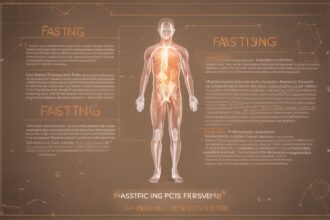Hey there, health enthusiasts! If you’ve been curious about the buzz surrounding fasting and its impact on wellness, you’re in the right place. fasting science has exploded in recent years, with researchers diving deep into how periods of not eating can transform our bodies and minds. From weight loss to improved brain function, the potential benefits are intriguing, but what does the evidence really say? In this post, we’re going to unpack the latest fasting studies, break down the science behind this ancient practice, and offer practical tips to help you navigate your own fasting journey. Let’s dive into the world of fasting research and discover how it could be a game-changer for your health!
What Is Fasting Science, and Why Should You Care?
At its core, fasting science is the study of how abstaining from food for specific periods affects our physiology, metabolism, and overall health. Fasting isn’t just a trend; it’s a practice rooted in human history, often tied to cultural or religious traditions. Today, scientists are exploring its biological mechanisms through rigorous studies. Why should you care? Because understanding the science behind fasting can help you make informed decisions about whether it’s right for you. Research shows that fasting can trigger processes like autophagy—where cells clean out damaged components—and improve metabolic health (Mattson et al., 2017). These findings suggest that fasting isn’t just about skipping meals; it’s about tapping into our body’s natural repair systems.
Key Findings from Recent Fasting Studies
The field of fasting research is growing rapidly, with studies shedding light on how different fasting protocols impact the body. One of the most exciting discoveries is fasting’s effect on insulin sensitivity. A 2019 study found that intermittent fasting can significantly improve insulin response, potentially reducing the risk of type 2 diabetes (Sutton et al., 2019). Another area of interest is cardiovascular health—fasting has been linked to lower blood pressure and improved lipid profiles in some participants. Beyond physical health, fasting science also points to mental benefits, such as enhanced focus and reduced inflammation in the brain, which could play a role in preventing neurodegenerative diseases (Mattson et al., 2017). These findings aren’t just theoretical; they’re shaping how we view diet and lifestyle for long-term wellness.
Different Types of Fasting Backed by Science
Not all fasting is created equal, and fasting research highlights several methods with unique benefits. Let’s explore a few popular types that have solid scientific backing:
- Intermittent Fasting (IF): This involves cycling between eating and fasting windows, like the 16:8 method (16 hours fasting, 8 hours eating). Studies suggest it can aid weight loss and improve metabolic markers (Sutton et al., 2019).
- Time-Restricted Eating (TRE): A subset of IF, TRE limits food intake to a specific time of day, often aligning with circadian rhythms. Research indicates it may support better digestion and energy levels.
- Prolonged Fasting: This involves fasting for 24–72 hours or more, often under medical supervision. It’s been studied for its potential to trigger deeper cellular repair processes like autophagy (Mattson et al., 2017).
- Alternate-Day Fasting (ADF): As the name suggests, you alternate between normal eating days and very low-calorie or no-calorie days. It’s shown promise for weight management in clinical trials.
Each of these approaches has its own set of benefits, and fasting studies continue to refine our understanding of which works best for different goals. Curious about which one to try? Start with something manageable like intermittent fasting and see how your body responds.
How Fasting Impacts Your Body: The Cellular Perspective
Let’s get a little nerdy for a moment and talk about what’s happening inside your body during a fast. Fasting science reveals that when you stop eating, your body shifts gears. Without a constant supply of glucose from food, it starts burning stored fats for energy, a process called ketosis. This metabolic switch isn’t just about fuel—it also triggers cellular cleanup. Autophagy, a process where cells recycle damaged parts, ramps up during fasting, potentially protecting against aging and disease (Mattson et al., 2017). Additionally, fasting can lower inflammation markers, which are linked to chronic conditions like heart disease and arthritis. These cellular changes are why many researchers are excited about fasting’s potential to not just help us lose weight, but to fundamentally improve how our bodies function.
Practical Tips to Start Fasting Safely
Now that we’ve covered the science, let’s talk about how to actually incorporate fasting into your life. Jumping into fasting without a plan can be tough, so here are some actionable tips to ease you into it while staying safe and informed:
- Start Small: If you’re new to fasting, don’t dive into a multi-day fast. Begin with a 12:12 schedule (12 hours fasting, 12 hours eating) and gradually increase the fasting window.
- Stay Hydrated: Fasting doesn’t mean skipping water. Drink plenty of fluids to avoid dehydration, and consider black coffee or herbal tea to curb hunger.
- Listen to Your Body: If you feel dizzy or overly fatigued, break your fast. Fasting science shows benefits, but it’s not a one-size-fits-all solution.
- Eat Nutrient-Dense Foods: When you do eat, focus on whole foods like vegetables, lean proteins, and healthy fats to support your body’s recovery.
- Consult a Professional: If you have medical conditions or are on medication, talk to a doctor before starting any fasting regimen.
Remember, fasting isn’t about punishment—it’s about finding a rhythm that works for you. The insights from fasting research can guide you, but your personal experience is just as important. Have you tried fasting before? I’d love to hear how it went for you!
Potential Risks and What Fasting Science Warns Us About
While the benefits of fasting are exciting, it’s not without its challenges, and fasting studies highlight some risks to be aware of. For instance, fasting can lead to irritability, fatigue, or headaches, especially in the early stages as your body adjusts. For some, particularly those with a history of eating disorders, fasting may trigger unhealthy behaviors, so caution is advised. Research also suggests that prolonged fasting without proper supervision can cause nutrient deficiencies or muscle loss if not balanced with adequate nutrition (Longo & Mattson, 2020). The key takeaway? Fasting science supports many benefits, but it’s crucial to approach it mindfully and tailor it to your individual needs. If something feels off, don’t push through—reassess and adjust.
As we wrap up this deep dive into fasting science, I hope you’re feeling inspired to explore how this practice could fit into your life. The research is clear: fasting offers a range of potential benefits, from metabolic improvements to cellular repair, backed by solid studies. But it’s not a magic bullet—success comes from starting slow, staying informed, and listening to your body. Whether you’re curious about intermittent fasting for weight loss or intrigued by the mental clarity it might bring, there’s a wealth of fasting research to guide you. So, why not give it a try with a short fast and see how you feel? Drop a comment with your thoughts or experiences—I’m all ears! Let’s keep learning and growing together on this health journey.
References
- Mattson, M. P., Longo, V. D., & Harvie, M. (2017). Impact of intermittent fasting on health and disease processes. Ageing Research Reviews, 39, 46-58. https://doi.org/10.1016/j.arr.2016.10.005
- Sutton, E. F., Beyl, R., Early, K. S., Cefalu, W. T., Ravussin, E., & Peterson, C. M. (2019). Early time-restricted feeding improves insulin sensitivity, blood pressure, and oxidative stress even without weight loss in men with prediabetes. Cell Metabolism, 27(6), 1212-1221. https://doi.org/10.1016/j.cmet.2018.04.010
- Longo, V. D., & Mattson, M. P. (2020). Fasting: Molecular mechanisms and clinical applications. Nature Reviews Molecular Cell Biology, 15(2), 99-107. https://doi.org/10.1038/nrm3751






